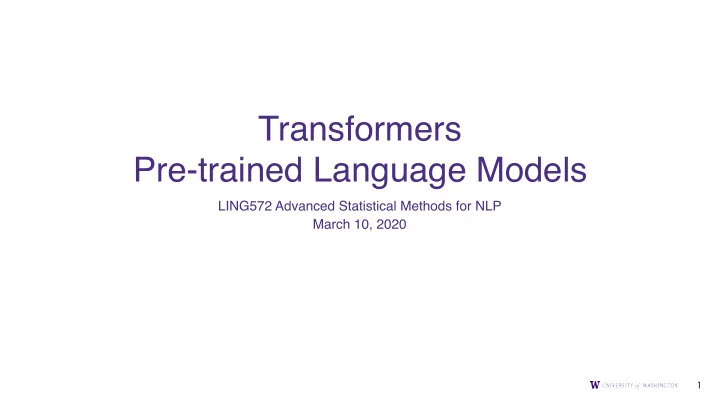

Language Modeling ● Recent innovation: use language modeling (a.k.a. next word prediction) ● And variants thereof ● Linguistic knowledge: ● The students were happy because ____ … ● The student was happy because ____ … ● World knowledge: ● The POTUS gave a speech after missiles were fired by _____ ● The Seattle Sounders are so-named because Seattle lies on the Puget _____ 28
Language Modeling is “Unsupervised” ● An example of “unsupervised” or “semi-supervised” learning ● NB: I think that “un-annotated” is a better term. Formally, the learning is supervised. But the labels come directly from the data, not an annotator. ● E.g.: “Today is the first day of 575.” ● (<s>, Today) ● (<s> Today, is) ● (<s> Today is, the) ● (<s> Today is the, first) ● … 29
Data for LM is cheap 30
Data for LM is cheap 30
Data for LM is cheap Text 30
Text is abundant ● News sites (e.g. Google 1B) ● Wikipedia (e.g. WikiText103) ● Reddit ● …. ● General web crawling: ● https://commoncrawl.org/ 31
The Revolution will not be [Annotated] Yann LeCun 32 https://twitter.com/rgblong/status/916062474545319938?lang=en
ULMFiT Universal Language Model Fine-tuning for Text Classification (ACL ’18) 33
ULMFiT 34
ULMFiT 35
Deep Contextualized Word Representations Peters et. al (2018) 36
Deep Contextualized Word Representations Peters et. al (2018) ● NAACL 2018 Best Paper Award 36
Deep Contextualized Word Representations Peters et. al (2018) ● NAACL 2018 Best Paper Award ● E mbeddings from L anguage Mo dels (ELMo) ● [aka the OG NLP Muppet] 36
Deep Contextualized Word Representations Peters et. al (2018) ● Comparison to GloVe: Source Nearest Neighbors playing, game, games, played, players, plays, player, Play, GloVe play football, multiplayer Chico Ruiz made a Kieffer, the only junior in the group, was commended for spectacular play on his ability to hit in the clutch, as well as his all-round Alusik’s grounder… excellent play. biLM Olivia De Havilland …they were actors who had been handed fat roles in a signed to do a successful play , and had talent enough to fill the roles Broadway play for competently, with nice understatement. Garson… 37
Deep Contextualized Word Representations Peters et. al (2018) ● Used in place of other embeddings on multiple tasks: SQuAD = Stanford Question Answering Dataset SNLI = Stanford Natural Language Inference Corpus SST -5 = Stanford Sentiment Treebank 38 figure: Matthew Peters
BERT: Bidirectional Encoder Representations from Transformers Devlin et al NAACL 2019 39
Overview ✓ ● Encoder Representations from Transformers: ● Bidirectional: ………? ● BiLSTM (ELMo): left-to-right and right-to-left ● Self-attention: every token can see every other ● How do you treat the encoder as an LM (as computing P ( w t | w t − 1 , w t − 2 , …, w 1 ) )? ● Don’t: modify the task 40
Masked Language Modeling ● Language modeling: next word prediction ● Masked Language Modeling (a.k.a. cloze task): fill-in-the-blank ● Nancy Pelosi sent the articles of ____ to the Senate. ● Seattle ____ some snow, so UW was delayed due to ____ roads. P ( w t | w t + k , w t +( k − 1) , …, w t +1 , w t − 1 , …, w t − ( m +1) , w t − m ) ● I.e. ● (very similar to CBOW: continuous bag of words from word2vec) ● Auxiliary training task: next sentence prediction. ● Given sentences A and B, binary classification: did B follow A in the corpus or not? 41
Schematically 42
Some details 43
Some details ● BASE model: ● 12 Transformer Blocks ● Hidden vector size: 768 ● Attention heads / layer: 12 ● Total parameters: 110M 43
Some details ● BASE model: ● 12 Transformer Blocks ● Hidden vector size: 768 ● Attention heads / layer: 12 ● Total parameters: 110M ● LARGE model: ● 24 Transformer Blocks ● Hidden vector size: 1024 ● Attention heads / layer: 16 ● Total parameters: 340M 43
Input Representation 44
Input Representation ● [CLS], [SEP]: special tokens 44
Input Representation ● [CLS], [SEP]: special tokens ● Segment: is this a token from sentence A or B? 44
Input Representation ● [CLS], [SEP]: special tokens ● Segment: is this a token from sentence A or B? ● Position embeddings: provide position in sequence (learned, not fixed, in this case) 44
Input Representation 🧑🧑🤕🤕 ● [CLS], [SEP]: special tokens ● Segment: is this a token from sentence A or B? ● Position embeddings: provide position in sequence (learned, not fixed, in this case) 44
WordPiece Embeddings ● Another solution to OOV problem, from NMT context (see Wu et al 2016) ● Main idea: ● Fix vocabulary size |V| in advance [for BERT: 30k] ● Choose |V| wordpieces (subwords) such that total number of wordpieces in the corpus is minimized ● Frequent words aren’t split, but rarer ones are ● NB: this is a small issue when you transfer to / evaluate on pre-existing tagging datasets with their own vocabularies. 45
Training Details ● BooksCorpus (800M words) + Wikipedia (2.5B) ● Masking the input text. 15% of all tokens are chosen. Then: ● 80% of the time: replaced by designated ‘[MASK]’ token ● 10% of the time: replaced by random token ● 10% of the time: unchanged ● Loss is cross-entropy of the prediction at the masked positions. ● Max seq length: 512 tokens (final 10%; 128 for first 90%) ● 1M training steps, batch size 256 = 4 days on 4 or 16 TPUs 46
Initial Results 47
Ablations ● Not a given (depth doesn’t help ELMo); possibly a difference between fine- tuning vs. feature extraction ● Many more variations to explore 48
Recommend
More recommend